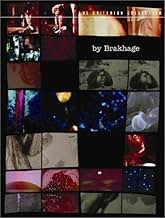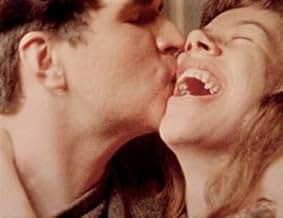Window Water Baby Moving
- 1959
- 13 min
AVALIAÇÃO DA IMDb
7,5/10
2,5 mil
SUA AVALIAÇÃO
Adicionar um enredo no seu idiomaStan Brakhage films the birth of his first child, Myrrena.Stan Brakhage films the birth of his first child, Myrrena.Stan Brakhage films the birth of his first child, Myrrena.
- Direção
- Artistas
Stan Brakhage
- Self
- (não creditado)
Myrrena Schwegmann
- Self (baby being born)
- (não creditado)
Jane Wodening
- Self
- (não creditado)
Avaliações em destaque
Some amazing footage of the birth of Brakhage's 1st child, shot with great explicitness, with no holding back- we see the 'birth' of the placenta, the baby crowning, etc. And while this is as explicit a birth as I've seen, the setting (at home) and the feeling of intimacy make it anything but clinical, or exploitive. It's really quite sweet.
On the other hand, Brakhage's insistence on rapid jump cuts, self-consciously oblique angles, etc worked in the other direction, pushing me away from a straightforward emotional experience. Which was, of course part of the intent. In making it not a documentary, but a subjective, somewhat surreal film, it seemed to be trying to go beyond a simple well-made telling. For me that worked well at times, but at others I'll admit to longing to finding the effects frustrating and not understanding exactly what they were trying to communicate emotionally or intellectually.
Beyond it's merits as a film, it was also important in that this kind of footage simply didn't exist at the time. It was initially seized by the Kodak lab, and Brakhage had to get a note from the doctor involved explaining it wasn't pornography (!). The film was part of the beginning of the movement towards accepting childbirth as beautiful and without need to be hidden, that fathers can and should be in the room to witness and take part, and that big white hospitals aren't the only place to have a baby. So it had an impact on a social as well as a cinematic level.
On the other hand, Brakhage's insistence on rapid jump cuts, self-consciously oblique angles, etc worked in the other direction, pushing me away from a straightforward emotional experience. Which was, of course part of the intent. In making it not a documentary, but a subjective, somewhat surreal film, it seemed to be trying to go beyond a simple well-made telling. For me that worked well at times, but at others I'll admit to longing to finding the effects frustrating and not understanding exactly what they were trying to communicate emotionally or intellectually.
Beyond it's merits as a film, it was also important in that this kind of footage simply didn't exist at the time. It was initially seized by the Kodak lab, and Brakhage had to get a note from the doctor involved explaining it wasn't pornography (!). The film was part of the beginning of the movement towards accepting childbirth as beautiful and without need to be hidden, that fathers can and should be in the room to witness and take part, and that big white hospitals aren't the only place to have a baby. So it had an impact on a social as well as a cinematic level.
An amazing avant-garde short of the birth of Brakhage's first child. This film is both graphic and beautiful while effecting each viewer a little differently. The colors in the film are especially striking. (Warning this film is not for the queazy).
While many women cringe at the thought of child birth and would never want to go through it, other women love children and are more than delighted to deliver a baby. I am a male, so I don't really have a true opinion, but I would really like to have a child someday. This film is essentially the birth of experimental filmmaker Stan Brakhage's first child. We witness his daughter being born without the sugarcoating or hiding the act. We see the birth in all of its glory. Many viewers will be nauseated with the sight, but others will be honored. This film is amazing because we see life actually being given and it is amazing. The human body is very complex, and the birthing process doesn't hide this fact. This is a film that people will watch for the ending. The ending makes the whole process worth it as the child turns out beautiful and We as viewers are treated to a loving sight of the child living and very healthy looking. This is the sweet side of Stan Brakhage. Usually his films involve the viewers in the difficulty of trying to figure out what he is trying to say, but this film is almost like a reward to the viewer. Children are beautiful and it is strange to realize that in twenty years, they will be running the country.
(I watched this film as part of the DVD short film collection of Stan Brakhage entitled, BY BRAKHAGE: AN ANTHOLOGY.)
(I watched this film as part of the DVD short film collection of Stan Brakhage entitled, BY BRAKHAGE: AN ANTHOLOGY.)
You ever see that cliché happening, if not in TV or movies then in real life, of the husband documenting every single excruciatingly painful but miraculous happening that is birth? Apparently, according to Stan Brakhage on the DVD this film is on, this trend was at least in part inspired by his original efforts. Shot on a minimal budget (save for what it must've cost to have a birth in the Brakhage household as opposed to the hospital), this film IS the difference between a simple 'home movie' and something close to the most personal art possible. Documentary film-making has always been about a subject that compels the filmmaker enough to get hours and hours of footage down. That here Brakhage, who often does montage work of paintings and the like, is focusing his subject matter on his wife, and his child just itching to get out, in all graphic detail, is astounding. For the 60's, when this was first released, it was probably a lot more shocking than now.
Not to say that the film isn't shocking, but it is on a different level than what you might see on one of those 'birth' shows on one of the Discovery channels. The way certain things are presented in the film are surprising, and (if you're a guy like me) definitely unnerving. But Brakhage somehow makes his film almost beautiful in a way by cutting the film's subject matter in half, so to speak. The first half is just the mother of his child, in a bathtub, feeling the baby kicking, et all. It's really just a great montage of the woman as a whole, nothing unseen, with the belly getting the most screen-time aside from the mother's face and genitals. Then comes the second part, the birth. Basically, if you still wonder how it works, in near unflinching detail, watch the film. That it is presented in such a grainy 16mm kind of filming, and still using the intense, mad montage of Brakhage's two cameras on her (I think it was two, one more close to the 'action' than the other).
And when it ends, it is, like all (practically) successful births, a miracle in and of itself. So much happens within these 13 minutes of film than, in a way, it feels longer. I loved how it dealt with its subject matter, which could be very tricky, and messy (the latter of which is very true), and was still a wonder for the eyes. It lacks music, which is sort of a pro and a con for me- you could do with some music, make it even more home movie-like. As it is, Brakhage has one of his most notorious- and possibly best- works here, and maybe the only film that makes that bridge between a health class and film class in school.
Not to say that the film isn't shocking, but it is on a different level than what you might see on one of those 'birth' shows on one of the Discovery channels. The way certain things are presented in the film are surprising, and (if you're a guy like me) definitely unnerving. But Brakhage somehow makes his film almost beautiful in a way by cutting the film's subject matter in half, so to speak. The first half is just the mother of his child, in a bathtub, feeling the baby kicking, et all. It's really just a great montage of the woman as a whole, nothing unseen, with the belly getting the most screen-time aside from the mother's face and genitals. Then comes the second part, the birth. Basically, if you still wonder how it works, in near unflinching detail, watch the film. That it is presented in such a grainy 16mm kind of filming, and still using the intense, mad montage of Brakhage's two cameras on her (I think it was two, one more close to the 'action' than the other).
And when it ends, it is, like all (practically) successful births, a miracle in and of itself. So much happens within these 13 minutes of film than, in a way, it feels longer. I loved how it dealt with its subject matter, which could be very tricky, and messy (the latter of which is very true), and was still a wonder for the eyes. It lacks music, which is sort of a pro and a con for me- you could do with some music, make it even more home movie-like. As it is, Brakhage has one of his most notorious- and possibly best- works here, and maybe the only film that makes that bridge between a health class and film class in school.
i liked his filmic style at first, his use of jump cuts and sped up footage was effective in portraying the woman's fear and angst although she looked calm on the outside. it also elevated the importance of the action of giving birth.
but i don't think the lingering graphic shots of the vagina bleeding did anything for the film and took me out of the rather mysterious tranquil feeling given off by the film previously.
he certainly knows how to make a film affecting but i won't want to watch it again and i don't think it conveyed any of the actualities of birth, the beauty and the miracle.
but i don't think the lingering graphic shots of the vagina bleeding did anything for the film and took me out of the rather mysterious tranquil feeling given off by the film previously.
he certainly knows how to make a film affecting but i won't want to watch it again and i don't think it conveyed any of the actualities of birth, the beauty and the miracle.
Você sabia?
- CuriosidadesIn the early 80's, Brakhage screened 'Window Water Baby Moving' to Andrei Tarkovsky who wasn't impressed with the film. Brakhage said in an interview: "The first film was Window Water Baby Moving. First of all I got nervous because Olga, who is teetering over me on the bureau, begins to sway. I've seen people faint at that film and I don't know, maybe she's never seen childbirth before. And then I see Tarkovsky's wife averting her face from the screen at times as you get to see some of the more explicit details of childbirth. ... Tarkovsky starts talking in rapid Russian, with Zanussi answering him, and whatever he's saying it's obviously angry. Finally, after a lot of these exchanges, Jane had the presence of mind to say, "What's going on? What's he saying?" So Zanussi starts translating and he says, "Well..." and we all wait, "Well... he says," and we wait some more, "he says that Art must have a mystery to it and this is too scientific to be Art.""
- ConexõesEdited into Alt-J: Pleader (2017)
Principais escolhas
Faça login para avaliar e ver a lista de recomendações personalizadas
Detalhes
- Data de lançamento
- País de origem
- Também conhecido como
- Window, Water, Baby, Moving
- Consulte mais créditos da empresa na IMDbPro
Contribua para esta página
Sugerir uma alteração ou adicionar conteúdo ausente

Principal brecha
By what name was Window Water Baby Moving (1959) officially released in Canada in English?
Responda















